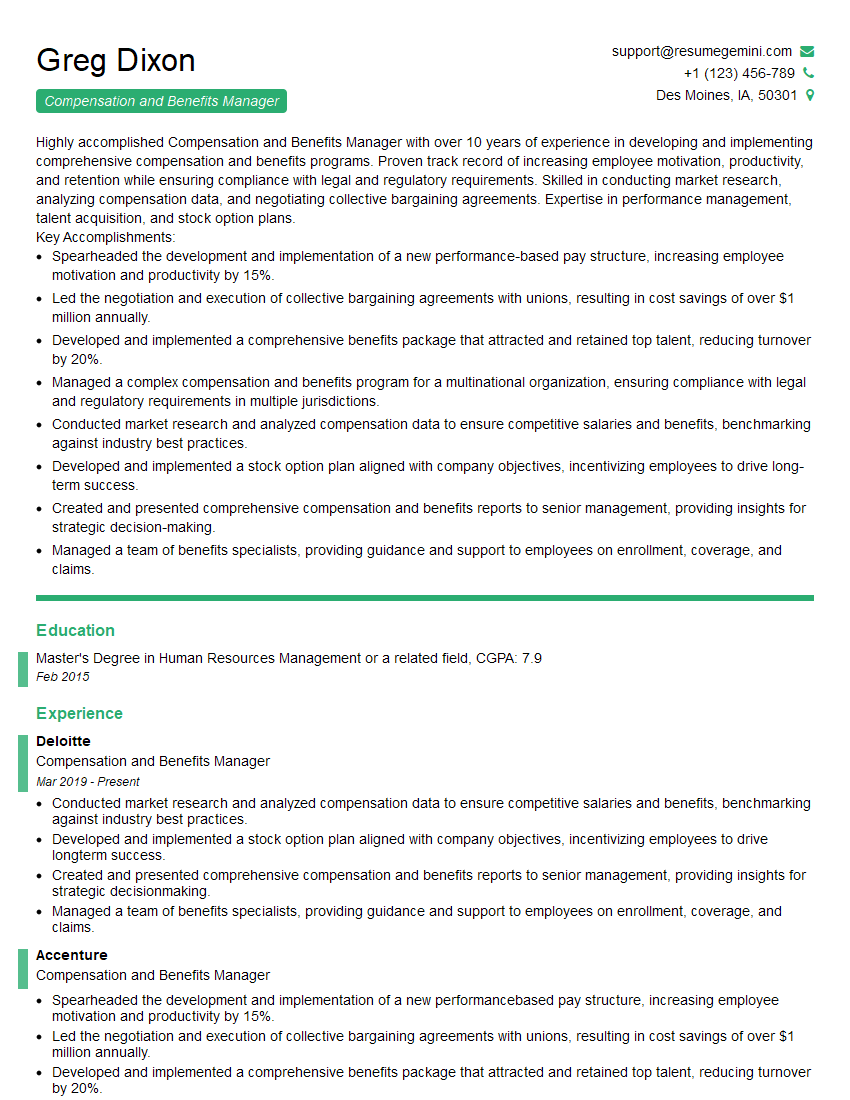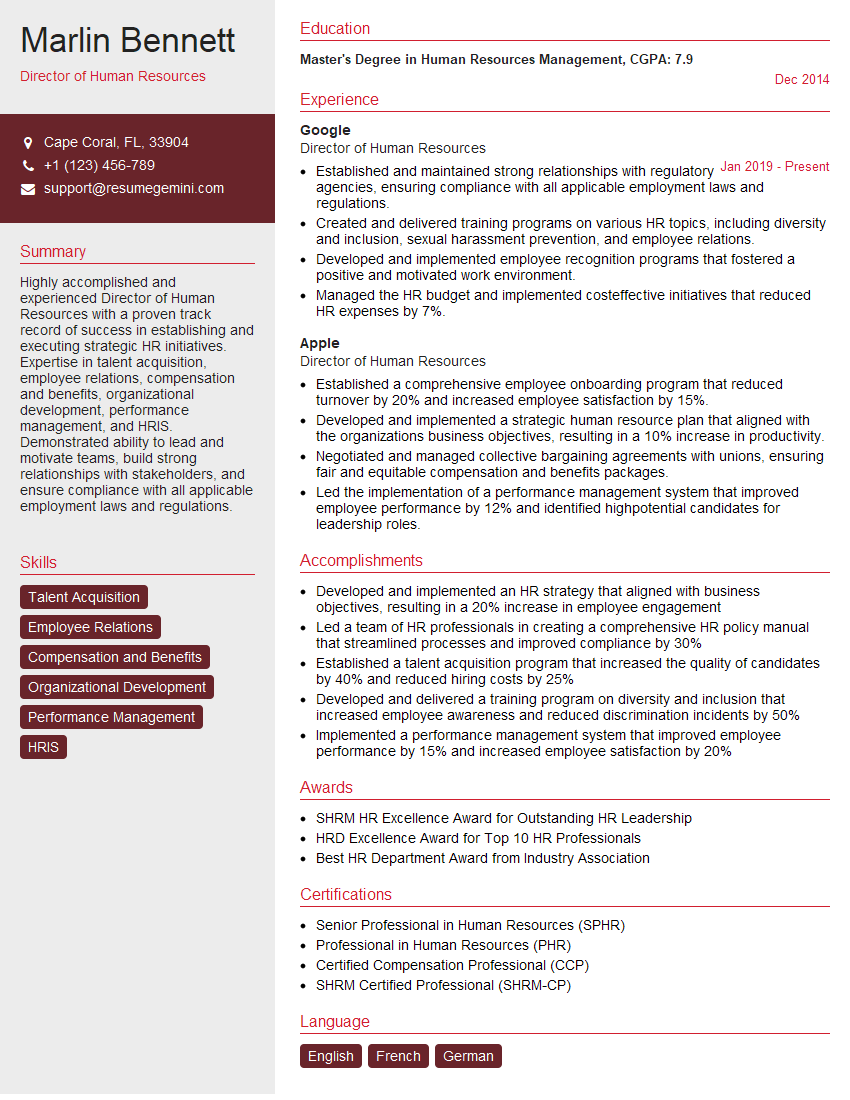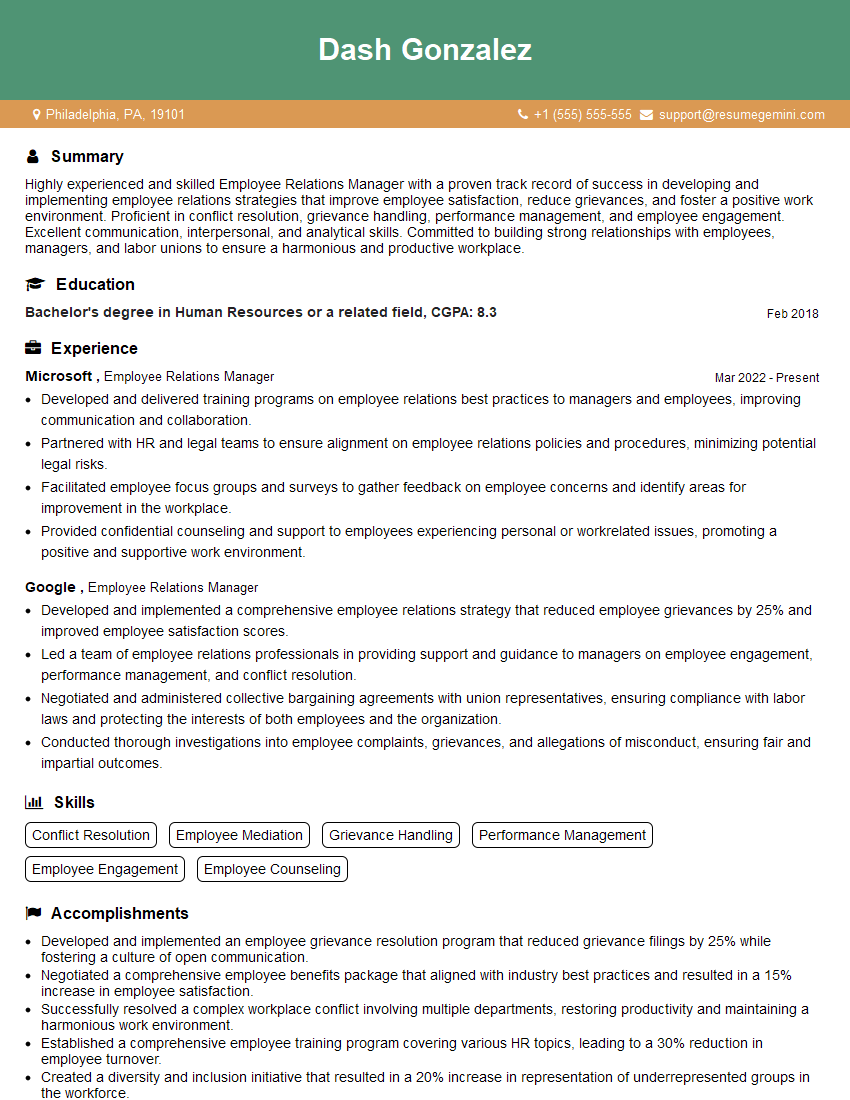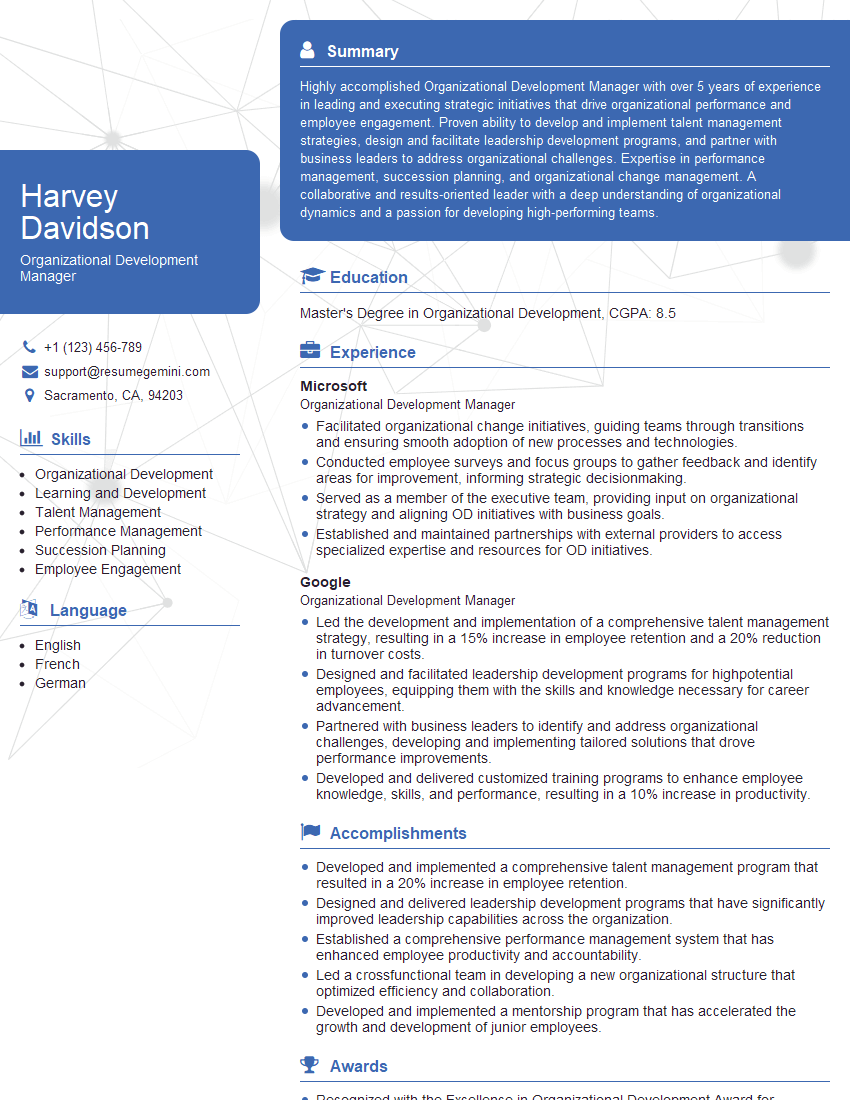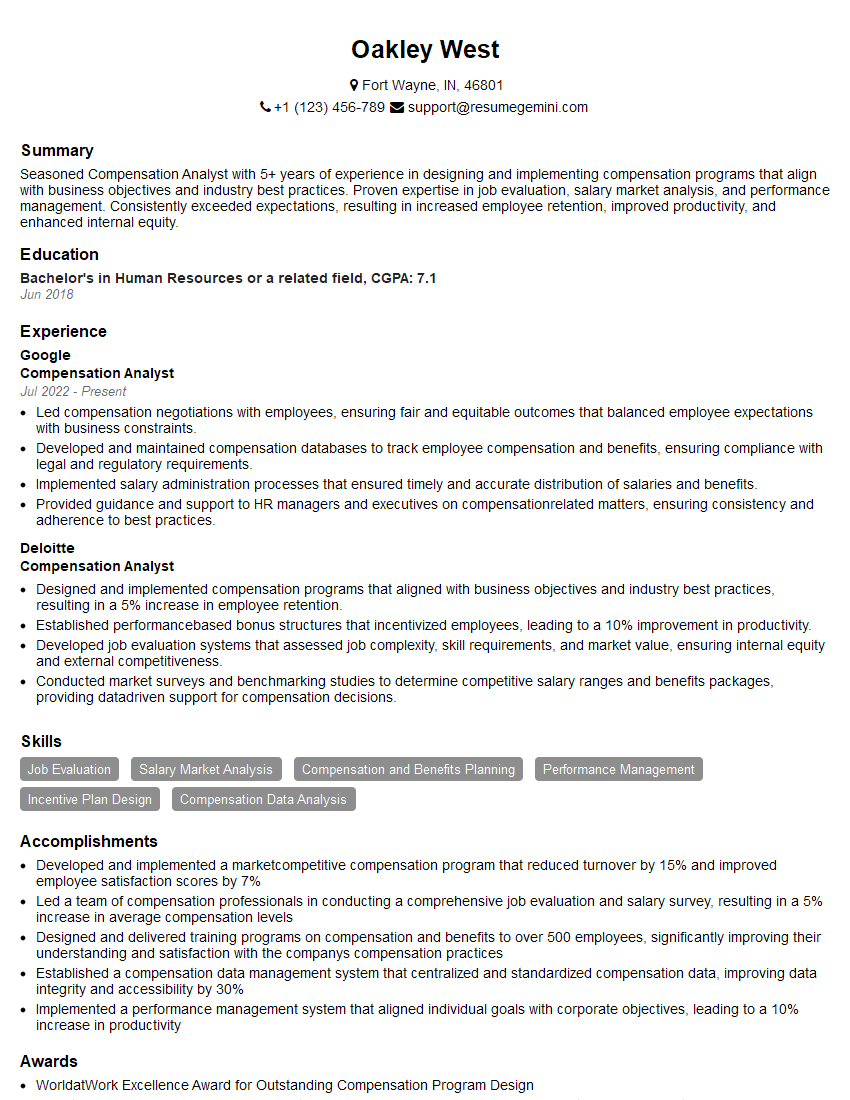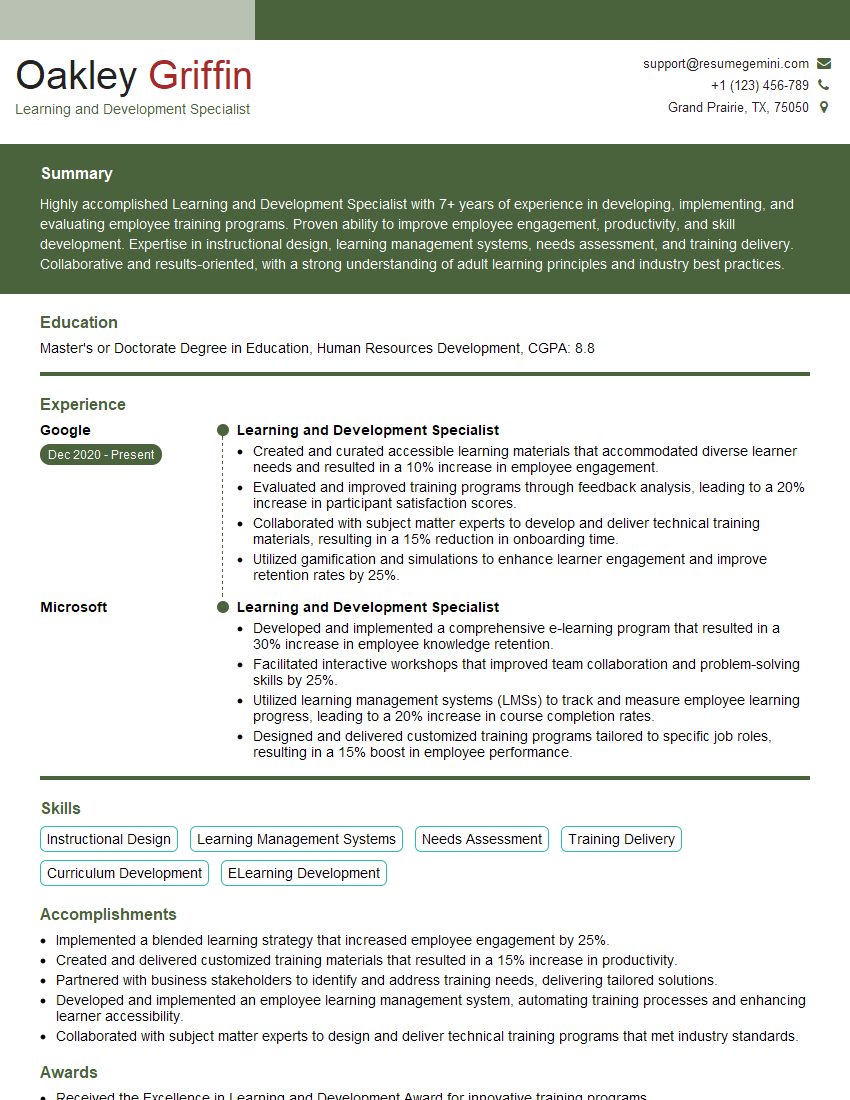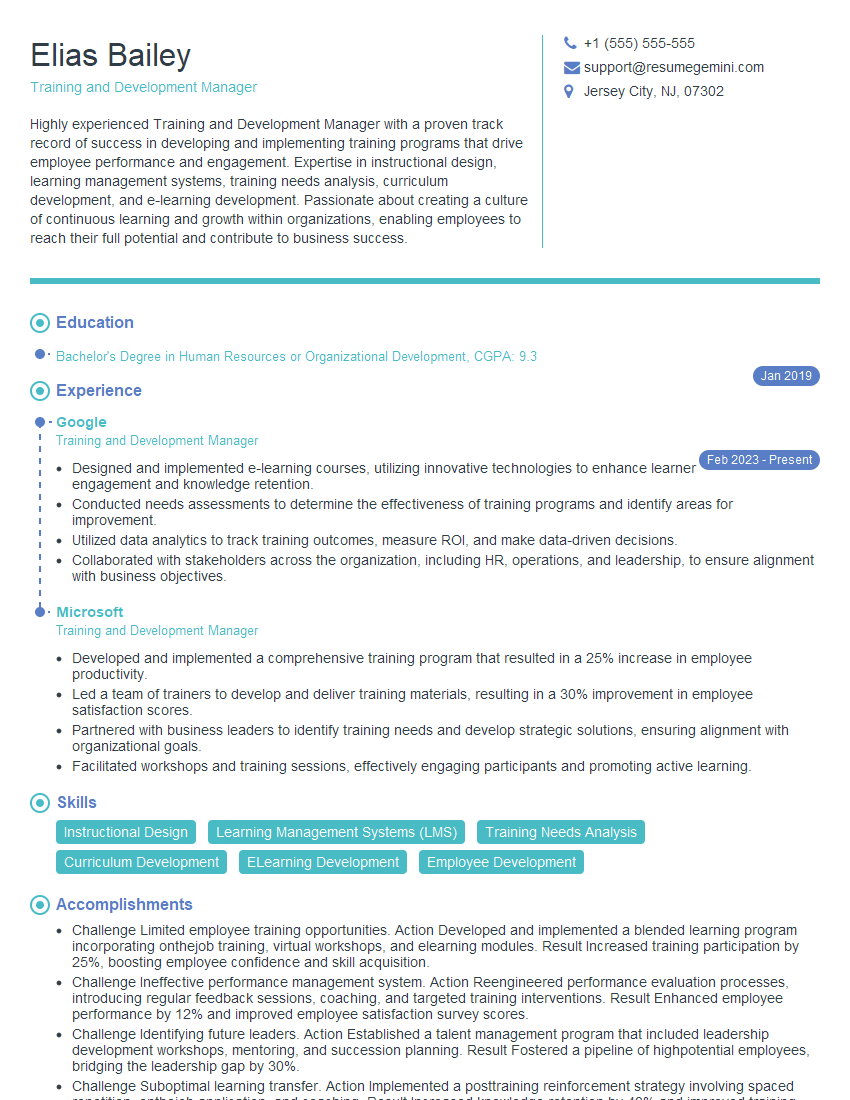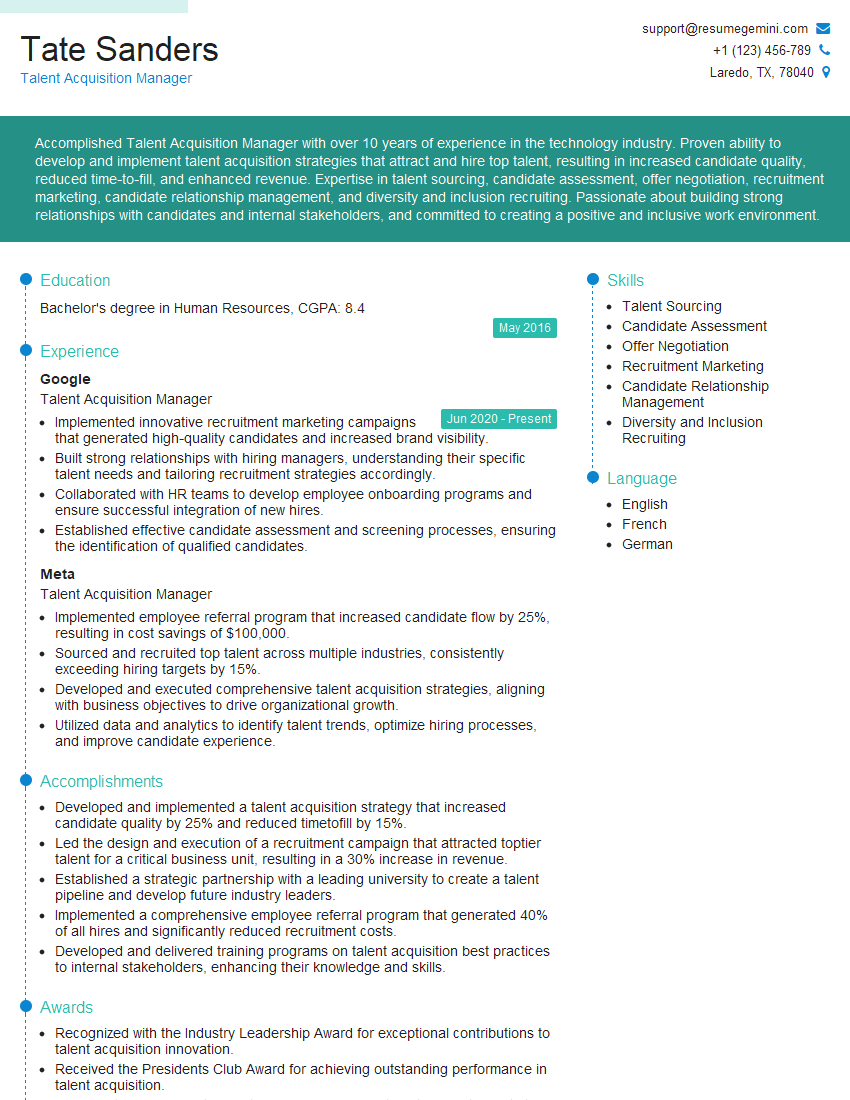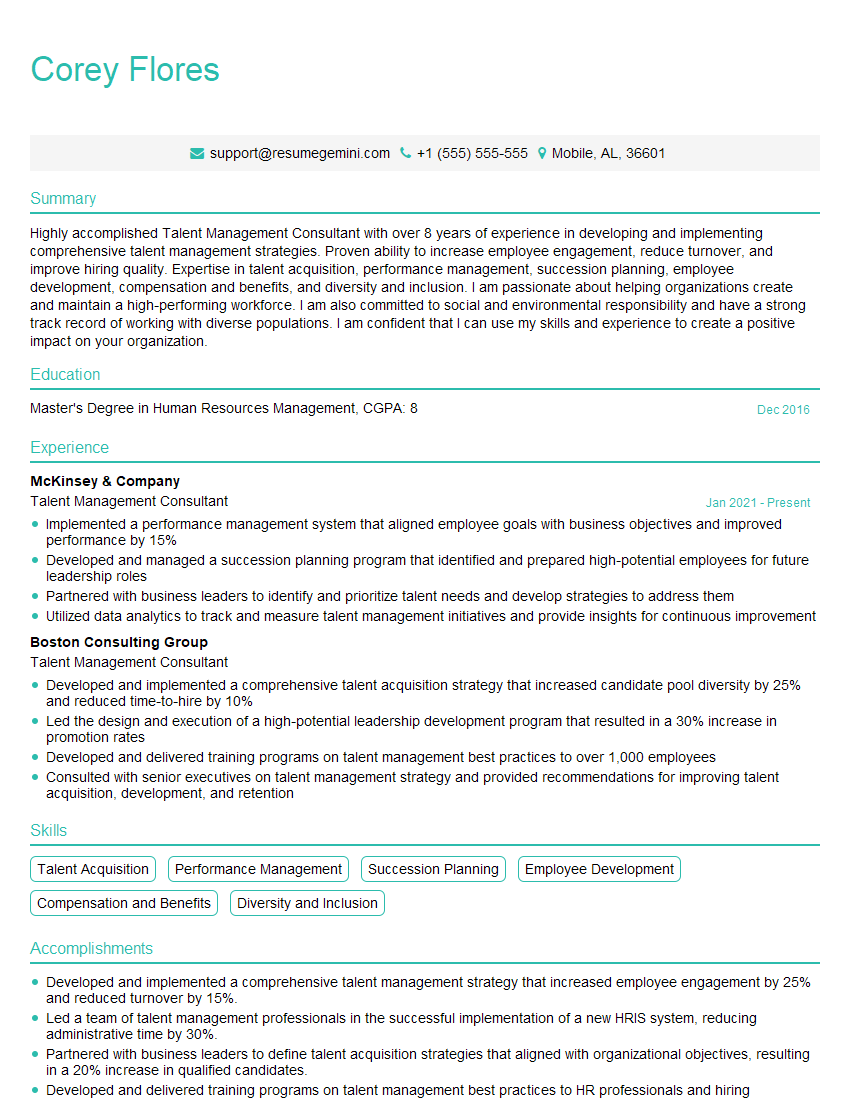Interviews are more than just a Q&A session—they’re a chance to prove your worth. This blog dives into essential Performance Review and Evaluation interview questions and expert tips to help you align your answers with what hiring managers are looking for. Start preparing to shine!
Questions Asked in Performance Review and Evaluation Interview
Q 1. Explain the difference between performance appraisal and performance management.
Performance appraisal and performance management are often used interchangeably, but they represent distinct yet interconnected concepts. Think of performance management as the overarching system designed to improve employee performance, while a performance appraisal is a specific point-in-time assessment of that performance.
Performance Management is a continuous, ongoing process encompassing goal setting, regular feedback, coaching, training, and development. It’s about proactively guiding employees towards success. It’s like navigating a journey, with ongoing adjustments and support.
Performance Appraisal, in contrast, is a formal evaluation typically conducted annually or semi-annually. It involves measuring an employee’s achievements against pre-defined goals and providing a summary assessment. It’s like taking a snapshot of progress at a specific point on the journey.
For example, a performance management system might include regular check-ins with managers, providing ongoing feedback and support. The annual performance appraisal would then summarize the employee’s accomplishments and areas for improvement throughout the year based on that continuous feedback.
Q 2. Describe your experience with different performance review methods (e.g., 360-degree feedback, self-assessment, goal setting).
Throughout my career, I’ve utilized various performance review methods, each offering unique insights. The best approach often involves a combination of methods for a holistic view.
- 360-degree feedback: This provides a comprehensive perspective by collecting feedback from an employee’s superiors, peers, subordinates, and even clients. In a past role, implementing a 360-degree feedback system for a sales team significantly improved team collaboration and individual performance by highlighting blind spots and fostering self-awareness. The key is to ensure anonymity and provide constructive feedback guidelines.
- Self-assessment: Encouraging employees to self-assess their performance promotes self-reflection and ownership. I’ve found that guiding employees with a structured self-assessment form, outlining key performance indicators (KPIs) and providing examples, enhances the quality of their self-evaluation. This allows them to reflect on their accomplishments and identify areas needing improvement before the formal review.
- Goal setting (SMART goals): This is crucial for setting clear expectations and measuring progress. I always advocate for collaboratively setting SMART goals (Specific, Measurable, Achievable, Relevant, Time-bound) with employees. This ensures alignment with organizational objectives and provides clear benchmarks for evaluation. For instance, instead of a vague goal like “improve sales,” a SMART goal would be “Increase sales by 15% in the next quarter by targeting new client segments.”
Q 3. How do you handle situations where an employee consistently underperforms?
Addressing consistent underperformance requires a structured and empathetic approach. It’s not about blame but about understanding the root cause and providing support for improvement.
- Documentation: First, I meticulously document all instances of underperformance, including specific examples and dates. This forms the basis for any subsequent discussions or actions.
- One-on-one Meeting: I schedule a private meeting with the employee to discuss the performance issues in a supportive, yet direct manner. The goal is to understand the underlying reasons for the underperformance – are there skill gaps, lack of resources, personal issues, or something else?
- Performance Improvement Plan (PIP): If the reasons for underperformance are addressed and improvement is not seen, a PIP may be necessary. A PIP outlines specific goals, timelines, and support mechanisms to help the employee improve. Regular check-ins are essential to monitor progress and offer guidance.
- Training and Development: Based on the identified reasons, I might recommend training or development opportunities to address any skill gaps or knowledge deficiencies.
- Progressive Discipline: If the employee fails to meet the objectives outlined in the PIP, progressive disciplinary actions, up to and including termination, may become necessary. This is always a last resort and should be documented thoroughly.
It’s crucial to maintain open communication and offer support throughout the process. My approach prioritizes helping the employee succeed, while simultaneously protecting the interests of the organization.
Q 4. What metrics do you use to measure the effectiveness of a performance management system?
Measuring the effectiveness of a performance management system requires focusing on both quantitative and qualitative metrics. Here are some examples:
- Employee Engagement: Higher engagement scores (through surveys) often correlate with a more effective system.
- Employee Turnover: A lower turnover rate suggests a positive and supportive work environment.
- Employee Satisfaction: Regular feedback and transparent processes contribute to higher job satisfaction.
- Goal Achievement Rate: The percentage of employees successfully achieving their goals is a key indicator of the system’s effectiveness.
- Performance Improvements: Tracking improvements in key performance indicators (KPIs) demonstrates the impact of the system.
- Manager Satisfaction: Managers’ perception of the system’s usability and effectiveness is crucial for its success. This can be measured via surveys or feedback sessions.
By tracking these metrics, I can identify areas for improvement in the system and ensure its continuous optimization.
Q 5. How do you ensure performance reviews are fair and unbiased?
Ensuring fairness and unbiasedness in performance reviews is paramount. Here’s how I approach it:
- Clearly Defined Criteria: Using standardized performance criteria ensures that all employees are evaluated against the same benchmarks, minimizing bias. These criteria should be communicated clearly to all employees beforehand.
- Multiple Data Sources: Relying on multiple sources of information – self-assessment, manager assessment, 360-degree feedback – mitigates the potential for individual biases.
- Calibration Sessions: Regular calibration sessions with managers help ensure consistency in evaluation across different teams and managers. This allows for discussion and alignment on rating scales and standards.
- Training for Managers: Managers should receive training on bias awareness and effective performance review techniques. This includes training on recognizing and mitigating their own biases.
- Appeals Process: A transparent and fair appeals process allows employees to voice concerns about their evaluations. This demonstrates a commitment to fairness and justice.
By systematically implementing these strategies, we strive to create a performance review process that is both fair and accurate.
Q 6. Describe your experience with performance improvement plans (PIPs).
Performance Improvement Plans (PIPs) are formal documents outlining specific steps an employee must take to improve their performance. I have significant experience developing and implementing PIPs. A key aspect is to ensure the PIP is not punitive but rather supportive and focused on improvement.
In my experience, a successful PIP includes:
- Clearly Defined Performance Issues: Specific examples of underperformance with supporting documentation.
- Measurable Goals: Specific, measurable goals with clear timelines for improvement.
- Support and Resources: Identification of resources and support (training, mentoring, coaching) available to help the employee succeed.
- Regular Check-ins: Scheduled meetings to monitor progress, provide feedback, and address any challenges.
- Consequences of Failure: Clear and documented consequences if the employee fails to meet the objectives outlined in the PIP. This should be communicated clearly upfront.
The key to a successful PIP is a collaborative approach, focusing on helping the employee improve, rather than simply documenting their failings.
Q 7. How do you address employee concerns regarding their performance reviews?
Addressing employee concerns regarding their performance reviews requires active listening, empathy, and a commitment to open communication. My approach typically involves:
- Active Listening: Carefully listening to the employee’s concerns without interruption. I focus on understanding their perspective and validating their feelings.
- Clarification and Explanation: Clearly explaining the rationale behind the evaluation, referencing specific examples and supporting documentation. I avoid jargon and use plain language.
- Review of the Evaluation: Jointly reviewing the evaluation to identify any potential areas of misunderstanding or misinterpretation.
- Actionable Steps: Collaboratively developing an action plan to address the concerns raised and outline areas for improvement. This might involve additional training, mentorship, or a revised set of goals.
- Documentation: Documenting the discussion, the concerns raised, and the agreed-upon action plan.
Addressing concerns promptly and transparently fosters trust and encourages employee engagement. It’s about creating a culture of continuous improvement and open dialogue.
Q 8. How do you integrate performance reviews with compensation and promotion decisions?
Performance reviews are the cornerstone of fair and effective compensation and promotion decisions. They shouldn’t be treated as isolated events but rather as integral components of a holistic performance management system. Ideally, a clear, documented link exists between performance ratings, compensation adjustments, and promotion opportunities.
For instance, employees consistently exceeding expectations (perhaps achieving a ‘Exceeds Expectations’ rating) might be eligible for higher merit increases, faster promotion tracks, or both. Conversely, employees consistently meeting expectations might receive standard salary increases and promotions based on seniority or availability. Those who consistently underperform might receive performance improvement plans and, if improvement isn’t achieved, may face consequences, such as salary freezes or, in extreme cases, termination.
This linkage must be transparent and consistently applied. A well-defined performance appraisal rubric and a transparent compensation structure are critical. Employee performance scores are usually weighted along with other factors, such as tenure, market value, and business needs, to ensure a holistic approach to compensation and promotions.
Q 9. What are some common challenges in implementing a performance management system, and how have you overcome them?
Implementing a successful performance management system presents several challenges. One common hurdle is resistance to change. Employees accustomed to outdated systems may be hesitant to adopt new processes. Another significant challenge is lack of buy-in from management. If managers don’t actively participate and champion the system, it won’t be effective. Furthermore, inconsistent application of standards across departments or managers can lead to perceptions of unfairness. Finally, lack of time for managers to conduct thorough reviews can lead to rushed and less effective evaluations.
To overcome these, I’ve found that proactive communication and training are essential. Clearly articulating the ‘why’ behind the new system and its benefits to both the employees and the organization helps to generate buy-in. Providing thorough training to managers on how to effectively conduct reviews and use the system’s tools is crucial. Regular calibration sessions among managers can ensure consistency in applying standards. To address time constraints, I’ve successfully implemented techniques like using shorter, more frequent check-ins instead of relying solely on annual reviews. This allows for continuous feedback and improvement, reducing the pressure of a single, high-stakes annual review.
Q 10. How do you ensure that performance reviews align with company goals and objectives?
Aligning performance reviews with company goals and objectives is crucial for ensuring everyone is working towards a common purpose. This starts with clearly defining the company’s strategic objectives and cascading them down to individual roles and responsibilities. Each employee’s Key Performance Indicators (KPIs) should directly reflect their contribution to these higher-level objectives.
For example, if a company’s goal is to increase market share by 15%, individual performance reviews should assess the employee’s contribution to that goal. This might involve examining sales figures, new customer acquisition rates, or marketing campaign effectiveness, depending on the role. The performance review form itself should explicitly include these KPIs and their connection to the overall strategic objectives. Regular communication and training, reinforcing the link between individual performance and company success, are crucial. Using a balanced scorecard approach, considering various aspects beyond financial performance (customer satisfaction, internal processes, and learning & growth), provides a holistic view of alignment.
Q 11. Explain the importance of providing regular feedback to employees.
Regular feedback is far more effective than annual performance reviews alone. It fosters a culture of continuous improvement and open communication. Instead of waiting a year to address performance issues or recognize accomplishments, regular feedback allows for immediate course correction and reinforcement of positive behaviors.
Think of it as navigating with a map versus only checking it once a year; regular feedback acts as a continuous GPS, guiding employees toward success. It allows for early identification of potential problems, preventing minor issues from escalating into major ones. Regular feedback also demonstrates that management cares about individual employee growth and development, boosting morale and job satisfaction. Providing both positive and constructive feedback is vital. Regular feedback can take many forms: informal one-on-ones, formal check-ins, or even quick notes of appreciation.
Q 12. How do you handle difficult conversations during performance reviews?
Difficult conversations during performance reviews require sensitivity, empathy, and a structured approach. Preparation is key. Begin by reviewing the employee’s performance data thoroughly, focusing on specific examples. Frame the conversation around facts and behaviors rather than personality judgments. Use the ‘Situation-Behavior-Impact’ model to describe situations, specific behaviors observed, and the impact of those behaviors. For example, ‘In the recent project launch (Situation), the deadline was missed due to insufficient planning (Behavior), leading to client dissatisfaction and additional costs (Impact).’
Active listening is critical. Allow the employee to share their perspective and respond with empathy before offering solutions. Collaboration on a Performance Improvement Plan (PIP) is often more effective than dictating changes. The PIP should include specific, measurable, achievable, relevant, and time-bound (SMART) goals. The review should conclude with agreed-upon steps and a follow-up schedule to monitor progress. It is also crucial to create a safe and respectful environment for the conversation, where employees feel comfortable expressing concerns and ideas.
Q 13. What strategies do you employ to improve employee engagement and motivation through performance management?
Performance management is a powerful tool for boosting employee engagement and motivation. It’s not just about evaluating past performance, but also about setting future goals and providing opportunities for growth. Clear and challenging goals, coupled with regular recognition for accomplishments, fosters a sense of purpose and accomplishment. Providing opportunities for skill development and career advancement demonstrates investment in employees’ futures, leading to increased loyalty and motivation.
Regular feedback, as previously discussed, is also essential. Employees who feel heard and valued are more likely to be engaged and motivated. In addition to formal reviews, fostering a culture of recognition – celebrating both individual and team accomplishments – significantly contributes to enhanced morale and performance. Empowering employees by giving them autonomy over their work and involving them in decision-making processes also boosts engagement. Finally, offering opportunities for mentorship and career development directly addresses employees’ growth aspirations, enhancing both their motivation and retention.
Q 14. Describe your experience using performance management software or technology.
I have extensive experience using various performance management software and technologies, including platforms like [mention specific software used, e.g., Workday, BambooHR, etc.]. These tools automate many aspects of the performance review process, such as goal setting, feedback collection, performance rating, and reporting. They significantly improve efficiency and ensure data consistency. For example, [mention a specific feature and its benefits, e.g., the automated reminders for reviews improved on-time completion rates by 20%].
Beyond the basic features, I’ve also leveraged advanced capabilities like performance analytics dashboards to track key metrics and identify trends. This data-driven approach helps us understand overall team performance, identify areas for improvement, and make data-informed decisions regarding talent development and compensation. My experience with these technologies allows for more objective evaluations, clearer communication, and better alignment with strategic goals. It also facilitates data analysis for future strategy adjustments.
Q 15. How do you ensure the confidentiality of performance review data?
Confidentiality of performance review data is paramount. We achieve this through a multi-layered approach. Firstly, access to the system is strictly controlled through role-based permissions. Only authorized personnel, typically the employee, their manager, and HR, have access. Secondly, data is encrypted both in transit and at rest, protecting it from unauthorized access even if the system were compromised. Thirdly, we have strict data handling policies that clearly outline who can access what data and for what purpose. Any breaches are immediately investigated and reported. Think of it like a high-security vault – multiple locks, strong walls, and a detailed log of every access attempt.
Regular audits and security assessments are conducted to identify and mitigate any vulnerabilities. Finally, employee training on data privacy is mandatory, ensuring everyone understands the importance of confidentiality and their responsibilities in maintaining it. This holistic approach safeguards sensitive performance information and fosters trust among employees.
Career Expert Tips:
- Ace those interviews! Prepare effectively by reviewing the Top 50 Most Common Interview Questions on ResumeGemini.
- Navigate your job search with confidence! Explore a wide range of Career Tips on ResumeGemini. Learn about common challenges and recommendations to overcome them.
- Craft the perfect resume! Master the Art of Resume Writing with ResumeGemini’s guide. Showcase your unique qualifications and achievements effectively.
- Don’t miss out on holiday savings! Build your dream resume with ResumeGemini’s ATS optimized templates.
Q 16. What is your experience with calibration sessions for performance reviews?
Calibration sessions are crucial for ensuring fairness and consistency in performance reviews. In my experience, these sessions involve managers gathering to discuss the performance of their direct reports, ensuring ratings align with pre-defined criteria and company standards. It’s like a quality control check for the entire performance review process. We use a structured approach where we review individual employee assessments, discussing specific examples and providing feedback to ensure objectivity.
I’ve found these sessions particularly helpful in addressing potential biases and ensuring that high performers are accurately recognized and underperformers receive appropriate support. Through calibration, we aim for a consistent application of standards across all teams, preventing unfair discrepancies in ratings.
Q 17. How do you measure the return on investment (ROI) of a performance management system?
Measuring the ROI of a performance management system requires a multifaceted approach. We can’t simply look at the cost of the system itself. Instead, we must consider the impact on key performance indicators (KPIs) like employee retention, productivity, and overall organizational performance. We can track metrics such as employee turnover rates, improvement in employee engagement scores, and increased sales or project completion rates following the implementation of the system.
For example, if employee turnover reduces by 10% after implementing a new performance management system that fostered improved employee engagement and development, we can calculate the cost savings associated with reduced recruitment and training costs. Similarly, if productivity increases by 5% due to improved goal setting and performance feedback, we can quantify the financial benefit of this increase. By comparing these improvements to the cost of implementing and maintaining the system, we can gain a clearer picture of its true ROI.
Q 18. Describe a time you had to coach an employee through a performance issue.
I once had to coach an employee, Sarah, who was consistently missing deadlines and her work quality was suffering. The first step was a private, open conversation to understand the root cause. It turned out Sarah was overwhelmed by a new project and lacked the necessary skills in project management. We didn’t jump to conclusions; we collaborated.
The coaching involved several steps. I provided her with additional training in project management, broke down her tasks into smaller, more manageable chunks, and implemented regular check-ins to monitor her progress and provide support. I also helped her prioritize tasks and encouraged her to utilize available resources. We celebrated small wins along the way. Within a few months, Sarah’s performance significantly improved, demonstrating the effectiveness of targeted coaching and support.
Q 19. How do you adapt your performance review approach to different employee levels and roles?
Adapting the performance review approach is crucial for effectiveness. For entry-level employees, the focus is usually on skill development, learning, and demonstrating basic competencies. Reviews emphasize feedback on learning progress and opportunities for growth, setting clear expectations for the role. For mid-level employees, the emphasis shifts towards performance against specific goals and contributions to team objectives. Reviews assess their ability to take initiative, lead projects, and mentor others.
Senior leaders, conversely, are assessed on their strategic thinking, leadership abilities, and impact on the organization’s overall success. For example, while a junior engineer’s review might focus on coding proficiency, a senior engineer’s review will assess their ability to lead projects, mentor others and bring innovative solutions. The key is to tailor the assessment criteria to reflect the roles and responsibilities at each level, focusing on what truly matters for their contribution and growth.
Q 20. What are some best practices for conducting effective performance reviews?
Effective performance reviews are a two-way conversation, not a one-sided evaluation. Best practices include establishing clear goals and expectations upfront, using a consistent and objective rating system, documenting specific examples of performance (both positive and negative), and providing constructive feedback. The process must be fair, regular and transparent.
Regular check-ins throughout the review period, not just during the formal review, are essential to provide ongoing support and address performance issues promptly. Furthermore, creating a safe and supportive environment where employees feel comfortable discussing their performance honestly is vital. Finally, establishing a clear action plan for improvement with measurable goals and timelines ensures that the review leads to tangible outcomes.
Q 21. How do you deal with employee resistance to performance feedback?
Employee resistance to feedback is common, often stemming from fear, defensiveness, or a perceived lack of fairness. The key is to approach the situation with empathy and understanding. Begin by actively listening to their concerns and validating their feelings. Framing the feedback as an opportunity for growth and development, rather than criticism, is crucial. Focus on specific behaviors and their impact, using the ‘situation-behavior-impact’ model.
For example, instead of saying ‘You’re not a team player,’ try ‘In the recent project, I noticed you didn’t contribute to the team discussions. This impacted the overall project timeline and the quality of the final outcome. How can we work together to improve this in the future?’ This approach is less confrontational and more likely to lead to a productive conversation focused on improvement. Collaboratively developing an action plan with the employee to address the areas for improvement can further demonstrate your commitment to supporting their success.
Q 22. How do you ensure that performance reviews are actionable and lead to improved performance?
Actionable performance reviews aren’t just about providing feedback; they’re about creating a roadmap for improvement. To ensure this, we need to move beyond vague statements and focus on specific, measurable, achievable, relevant, and time-bound (SMART) goals.
- Specific: Instead of ‘improve communication,’ the goal should be ‘attend active listening training and implement at least three strategies in team meetings by the end of the quarter.’
- Measurable: Progress should be trackable. For example, ‘increase sales by 15% in the next six months’ is measurable, while ‘improve sales performance’ is not.
- Achievable: Goals need to be realistic, challenging but attainable within the given timeframe and resources.
- Relevant: Goals must align with the employee’s role, team objectives, and the overall company strategy.
- Time-bound: Setting deadlines creates urgency and accountability.
Furthermore, the review should include a collaborative discussion about how the employee will achieve these goals, including identifying potential obstacles and developing strategies to overcome them. Regular check-ins throughout the review period are crucial to monitor progress, provide support, and make necessary adjustments.
For instance, if an employee consistently misses deadlines, a SMART goal might be: ‘Improve time management by implementing a project planning system and completing all assigned tasks on time for the next two months, as measured by project completion reports.’ This includes providing access to time management training and regular check-ins.
Q 23. How do you use performance data to inform talent development initiatives?
Performance data is a goldmine for identifying talent development needs. By analyzing performance reviews, we can identify recurring strengths and weaknesses across the team or individual employees. This data can be used to inform several initiatives:
- Targeted Training Programs: If reviews consistently highlight a lack of proficiency in a specific skill, we can design and implement focused training programs to address that gap. For example, if sales representatives consistently struggle with closing deals, a training program on negotiation and sales techniques could be developed.
- Mentorship and Coaching: Performance data can help identify employees who would benefit from mentorship or coaching. For instance, high-potential employees who need guidance in leadership skills could be paired with experienced mentors.
- Succession Planning: Analyzing performance data helps identify high-performing employees with leadership potential, allowing for proactive succession planning.
- Career Pathing: Strengths identified in performance reviews can help guide employees toward roles that best utilize their skills and talents, fostering job satisfaction and retention.
For example, if a performance review consistently highlights an employee’s exceptional analytical skills but points out a need for improvement in presentation skills, we could offer them advanced analytics training and workshops on public speaking.
Q 24. What are some common mistakes to avoid during performance reviews?
Several common mistakes can undermine the effectiveness of performance reviews. Avoiding these pitfalls is crucial for a fair and productive process:
- Focusing solely on recent events: A holistic review should cover the entire review period, not just the most recent weeks or months.
- Lack of preparation: Both the manager and the employee should come prepared with specific examples and data to support their feedback.
- Unclear expectations: Ambiguous goals and performance criteria create confusion and make it difficult to assess progress accurately.
- Using vague or subjective language: Instead of ‘needs improvement,’ provide specific examples and suggestions for improvement.
- Ignoring the employee’s perspective: A two-way conversation is vital. Allow employees to share their perspectives, challenges, and suggestions.
- Focusing solely on negatives: Highlight both strengths and weaknesses, focusing on constructive feedback and opportunities for growth.
- Lack of follow-up: The review process shouldn’t end with the meeting. Establish clear action items and follow up regularly to track progress and offer support.
For instance, instead of saying ‘your communication skills need improvement,’ a better approach would be: ‘In the last quarter, there were instances where your email responses lacked sufficient detail. Let’s discuss strategies to ensure clarity in your written communication.’
Q 25. Explain your understanding of legal compliance regarding performance reviews.
Legal compliance in performance reviews is critical. The process must be fair, objective, and free from discrimination. Key legal considerations include:
- Non-discrimination: Reviews must be free from bias based on race, religion, gender, age, national origin, disability, or any other protected characteristic.
- Documentation: Maintain detailed, accurate, and contemporaneous records of performance, including specific examples of both positive and negative performance. This documentation is crucial for defending against potential legal challenges.
- Due process: Employees should have the opportunity to review their performance evaluations and provide feedback before they are finalized. They should also have a clear process for appealing any decisions made based on the review.
- Consistency: Apply performance standards consistently across all employees.
- Job-related criteria: Performance evaluations should focus on job-related criteria and avoid subjective or personal opinions.
Failure to comply with these legal requirements can result in significant legal repercussions, including lawsuits and hefty fines. Therefore, it’s crucial to have a well-defined performance review process that is aligned with all relevant employment laws and regulations. Regular review and updates to this process are also essential to ensure it stays current with legal changes.
Q 26. How do you ensure that performance reviews are aligned with diversity, equity, and inclusion (DE&I) initiatives?
Aligning performance reviews with DE&I initiatives requires a conscious effort to eliminate bias and create a fair and inclusive environment. This involves:
- Bias training for managers: Equip managers with the knowledge and skills to recognize and mitigate unconscious biases in their evaluations.
- Standardized evaluation criteria: Develop clear, objective, and standardized criteria to minimize subjective interpretations and potential biases.
- Diverse review panels: Consider using diverse review panels to provide multiple perspectives and reduce bias.
- Anonymous feedback mechanisms: Incorporate anonymous feedback mechanisms to encourage honest and candid feedback from colleagues and peers, reducing the impact of personal biases.
- Regular audits of performance data: Conduct regular audits to identify any potential biases or inconsistencies in performance evaluations.
- Focus on inclusive leadership behaviors: Include criteria in performance reviews that measure inclusive leadership behaviors, such as fostering collaboration and valuing diverse perspectives.
For example, instead of relying solely on manager feedback, incorporate 360-degree feedback to obtain a more comprehensive and less biased view of an employee’s performance.
Q 27. How do you maintain the integrity of the performance review process?
Maintaining the integrity of the performance review process is crucial for its effectiveness and fairness. Key strategies include:
- Clear and consistent guidelines: Establish clear and consistent guidelines for conducting performance reviews, ensuring all managers follow the same procedures and criteria.
- Regular training for managers: Provide ongoing training for managers on best practices for conducting performance reviews, including how to provide constructive feedback, handle difficult conversations, and avoid bias.
- Calibration sessions: Conduct calibration sessions among managers to ensure consistency in ratings and feedback across teams. This helps minimize discrepancies and ensures fairness.
- Confidential handling of data: Treat all performance data as confidential and protect employee privacy.
- Regular review and updates: Regularly review and update the performance review process to ensure it remains relevant, effective, and aligned with the organization’s goals and legal requirements.
- Open communication and feedback channels: Encourage open communication and provide channels for employees to raise concerns or provide feedback about the performance review process.
For instance, a regular review of the performance appraisal forms, metrics, and feedback mechanisms can help identify areas needing improvement and ensure alignment with the evolving needs of the company and its employees.
Q 28. How do you track and measure the effectiveness of performance improvement plans?
Tracking and measuring the effectiveness of performance improvement plans (PIPs) is essential to ensure they are achieving their intended goals. This involves:
- Clearly defined goals and metrics: PIPs must have clearly defined, measurable goals with specific metrics to track progress.
- Regular check-ins: Schedule regular check-in meetings with the employee to monitor progress, provide support, and make any necessary adjustments to the plan.
- Documentation of progress: Maintain detailed documentation of the employee’s progress, including any challenges encountered and solutions implemented.
- Use of multiple data points: Don’t rely solely on self-reported data. Use a variety of data points, such as performance metrics, peer feedback, and project outcomes, to assess progress.
- Evaluation of the PIP: At the end of the PIP period, evaluate its effectiveness in achieving its goals. This evaluation should inform future PIPs and overall performance management strategies.
For example, if a PIP aims to improve sales performance, the metrics could include the number of sales calls made, the value of sales closed, and customer satisfaction scores. Regular check-ins would help identify challenges, such as lack of lead generation, and adjust the PIP accordingly.
Key Topics to Learn for Performance Review and Evaluation Interview
- Performance Management Frameworks: Understanding different models (e.g., goal setting, 360-degree feedback, competency-based) and their practical application in various organizational settings.
- Goal Setting and Performance Measurement: Developing SMART goals, using appropriate metrics, and aligning individual contributions with organizational objectives. Consider the challenges of measuring qualitative performance.
- Conducting Effective Performance Reviews: Mastering techniques for providing constructive feedback, addressing performance issues with tact and diplomacy, and fostering open communication during review sessions.
- Bias Mitigation in Performance Evaluation: Recognizing and mitigating potential biases (e.g., halo effect, recency bias) to ensure fair and objective assessments.
- Performance Improvement Plans (PIPs): Developing and implementing PIPs effectively, focusing on support and development rather than solely on punishment. Understanding the legal considerations.
- Legal Compliance and Documentation: Understanding relevant employment laws and regulations concerning performance reviews and evaluations. Maintaining accurate and comprehensive documentation.
- Data Analysis and Reporting: Utilizing performance data to identify trends, inform strategic decisions, and demonstrate the impact of performance management initiatives. Experience with relevant software is a plus.
- Calibration and Standardization: Ensuring consistency and fairness across different raters and teams through calibration processes. Understanding the benefits and challenges of standardization.
Next Steps
Mastering Performance Review and Evaluation is crucial for career advancement in HR, management, and related fields. It demonstrates your ability to contribute significantly to organizational success through effective talent management. To significantly improve your job prospects, crafting an ATS-friendly resume is essential. ResumeGemini is a trusted resource that can help you build a professional and impactful resume tailored to highlight your skills and experience. Examples of resumes specifically designed for Performance Review and Evaluation roles are available through ResumeGemini to help you get started.
Explore more articles
Users Rating of Our Blogs
Share Your Experience
We value your feedback! Please rate our content and share your thoughts (optional).
What Readers Say About Our Blog
Hello,
We found issues with your domain’s email setup that may be sending your messages to spam or blocking them completely. InboxShield Mini shows you how to fix it in minutes — no tech skills required.
Scan your domain now for details: https://inboxshield-mini.com/
— Adam @ InboxShield Mini
Reply STOP to unsubscribe
Hi, are you owner of interviewgemini.com? What if I told you I could help you find extra time in your schedule, reconnect with leads you didn’t even realize you missed, and bring in more “I want to work with you” conversations, without increasing your ad spend or hiring a full-time employee?
All with a flexible, budget-friendly service that could easily pay for itself. Sounds good?
Would it be nice to jump on a quick 10-minute call so I can show you exactly how we make this work?
Best,
Hapei
Marketing Director
Hey, I know you’re the owner of interviewgemini.com. I’ll be quick.
Fundraising for your business is tough and time-consuming. We make it easier by guaranteeing two private investor meetings each month, for six months. No demos, no pitch events – just direct introductions to active investors matched to your startup.
If youR17;re raising, this could help you build real momentum. Want me to send more info?
Hi, I represent an SEO company that specialises in getting you AI citations and higher rankings on Google. I’d like to offer you a 100% free SEO audit for your website. Would you be interested?
Hi, I represent an SEO company that specialises in getting you AI citations and higher rankings on Google. I’d like to offer you a 100% free SEO audit for your website. Would you be interested?
good
